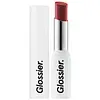What's inside
What's inside
 Key Ingredients
Key Ingredients

 Benefits
Benefits

 Concerns
Concerns

 Ingredients Side-by-side
Ingredients Side-by-side

Hydrogenated Polyisobutene
EmollientDimethicone
EmollientCetearyl Ethylhexanoate
EmollientMicrocrystalline Wax
Emulsion StabilisingCaprylic/Capric Triglyceride
MaskingPolyethylene
AbrasiveSilica
AbrasiveTrimethylolpropane Triisostearate
EmollientDimethicone/Vinyl Dimethicone Crosspolymer
Skin ConditioningKaolin
AbrasiveSynthetic Wax
AbrasiveBis-Diglyceryl Polyacyladipate-2
EmollientMica
Cosmetic ColorantCopernicia Cerifera Cera
EmollientStearalkonium Hectorite
Gel FormingPolyhydroxystearic Acid
EmulsifyingPentaerythrityl Tetra-Di-T-Butyl Hydroxyhydrocinnamate
AntioxidantPropylene Carbonate
SolventRosa Canina Fruit Oil
EmollientPassiflora Edulis Seed Acid
BleachingTocopherol
AntioxidantHydrogenated Polyisobutene, Dimethicone, Cetearyl Ethylhexanoate, Microcrystalline Wax, Caprylic/Capric Triglyceride, Polyethylene, Silica, Trimethylolpropane Triisostearate, Dimethicone/Vinyl Dimethicone Crosspolymer, Kaolin, Synthetic Wax, Bis-Diglyceryl Polyacyladipate-2, Mica, Copernicia Cerifera Cera, Stearalkonium Hectorite, Polyhydroxystearic Acid, Pentaerythrityl Tetra-Di-T-Butyl Hydroxyhydrocinnamate, Propylene Carbonate, Rosa Canina Fruit Oil, Passiflora Edulis Seed Acid, Tocopherol
Hydrogenated Polyisobutene
EmollientSynthetic Wax
AbrasiveCaprylic/Capric Triglyceride
MaskingSynthetic Fluorphlogopite
Vinyl Dimethicone/Methicone Silsesquioxane Crosspolymer
Bis-Diglyceryl Polyacyladipate-2
EmollientPolymethylsilsesquioxane
Kaolin
AbrasiveTridecyl Trimellitate
EmollientEuphorbia Cerifera Wax
Boron Nitride
AbsorbentIsododecane
EmollientSodium Hyaluronate
HumectantAgave Tequilana Leaf Extract
AstringentCarthamus Tinctorius Seed Oil
MaskingHelianthus Annuus Seed Wax
Skin ConditioningHelianthus Annuus Seed Oil
EmollientRicinus Communis Seed Oil
MaskingTocopheryl Acetate
AntioxidantTocopherol
AntioxidantDimethicone
EmollientDimethicone Crosspolymer-3
Skin ConditioningIsopropyl Titanium Triisostearate
EmollientDimethicone Crosspolymer
Emulsion StabilisingCaprylyl Glycol
EmollientIron Oxides
CI 15850
Cosmetic ColorantHydrogenated Polyisobutene, Synthetic Wax, Caprylic/Capric Triglyceride, Synthetic Fluorphlogopite, Vinyl Dimethicone/Methicone Silsesquioxane Crosspolymer, Bis-Diglyceryl Polyacyladipate-2, Polymethylsilsesquioxane, Kaolin, Tridecyl Trimellitate, Euphorbia Cerifera Wax, Boron Nitride, Isododecane, Sodium Hyaluronate, Agave Tequilana Leaf Extract, Carthamus Tinctorius Seed Oil, Helianthus Annuus Seed Wax, Helianthus Annuus Seed Oil, Ricinus Communis Seed Oil, Tocopheryl Acetate, Tocopherol, Dimethicone, Dimethicone Crosspolymer-3, Isopropyl Titanium Triisostearate, Dimethicone Crosspolymer, Caprylyl Glycol, Iron Oxides, CI 15850
 Reviews
Reviews

Alternatives
Ingredients Explained
These ingredients are found in both products.
Ingredients higher up in an ingredient list are typically present in a larger amount.
This ingredient is lipid-based synthetic skin-conditioning agent derived from adipic acid and a mixture of fatty acids. It is often called a lanolin substitute.
As an emollient, it helps soften and hydrate the skin. Emollients create a barrier on the skin to trap moisture in.
Due to its fatty acid base, it may not be Malassezia folliculitis safe.
Learn more about Bis-Diglyceryl Polyacyladipate-2This ingredient is an emollient, solvent, and texture enhancer. It is considered a skin-softener by helping the skin prevent moisture loss.
It helps thicken a product's formula and makes it easier to spread by dissolving clumping compounds.
Caprylic Triglyceride is made by combining glycerin with coconut oil, forming a clear liquid.
While there is an assumption Caprylic Triglyceride can clog pores due to it being derived from coconut oil, there is no research supporting this.
Learn more about Caprylic/Capric TriglycerideDimethicone is a type of synthetic silicone created from natural materials such as quartz.
What it does:
Dimethicone comes in different viscosities:
Depending on the viscosity, dimethicone has different properties.
Ingredients lists don't always show which type is used, so we recommend reaching out to the brand if you have questions about the viscosity.
This ingredient is unlikely to cause irritation because it does not get absorbed into skin. However, people with silicone allergies should be careful about using this ingredient.
Note: Dimethicone may contribute to pilling. This is because it is not oil or water soluble, so pilling may occur when layered with products. When mixed with heavy oils in a formula, the outcome is also quite greasy.
Learn more about DimethiconeHydrogenated Polyisobutene is a synthetic polymer. Polymers are compounds with high molecular weight. Hydrogenated Polyisobutene is an emollient and texture enhancer.
In one study, Hydrogenated Polyisobutene showed better skin hydration levels than Caprylic/Capric Triglyceride. As an emollient, it helps keep your skin soft and hydrated by trapping moisture in.
Hydrogenated Polyisobutene is often used as a mineral oil replacement.
Learn more about Hydrogenated PolyisobuteneKaolin is a clay. It is used for oil control and to help minimize pores. Like other clays, kaolin has the ability to absorb excess sebum or oil. This can help clean out pores and mattify the skin.
Some types of kaolin may have exfoliating properties. When water is added to kaolin, it becomes a paste with small abrasive particles.
Most kaolin is a white color, but may be pink/orange/red depending on where it comes from.
The name 'kaolin' comes from a Chinese village named 'Gaoling'. Kaolin clay comes from rocks rich in kaolinite. Kaolinite, the mineral, has a silicate layered structure. Kaolinite is formed from chemical weathering of aluminum siilicate minerals.
Besides skincare, kaolin is commonly used to make glossy paper, in ceramics, toothpaste, and as medicine to soothe stomach issues.
Learn more about KaolinSynthetic Wax is created from fossil fuels such as natural gas. It is used to enhance texture, adjust pH, and as an occlusive.
It may also be used as an abrasive ingredient to exfoliate the skin.
Synthetic Wax may not be fungal acne safe.
Learn more about Synthetic WaxTocopherol (also known as Vitamin E) is a common antioxidant used to help protect the skin from free-radicals and strengthen the skin barrier. It's also fat soluble - this means our skin is great at absorbing it.
Vitamin E also helps keep your natural skin lipids healthy. Your lipid skin barrier naturally consists of lipids, ceramides, and fatty acids. Vitamin E offers extra protection for your skin’s lipid barrier, keeping your skin healthy and nourished.
Another benefit is a bit of UV protection. Vitamin E helps reduce the damage caused by UVB rays. (It should not replace your sunscreen). Combining it with Vitamin C can decrease sunburned cells and hyperpigmentation after UV exposure.
You might have noticed Vitamin E + C often paired together. This is because it is great at stabilizing Vitamin C. Using the two together helps increase the effectiveness of both ingredients.
There are often claims that Vitamin E can reduce/prevent scarring, but these claims haven't been confirmed by scientific research.
Learn more about Tocopherol